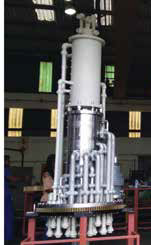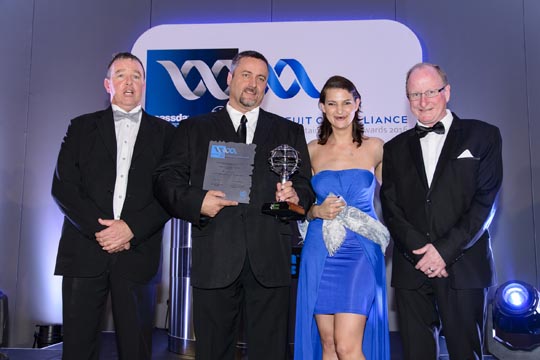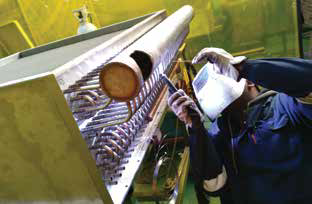- Sassda Columbus Stainless Awards 2016
- 2016 Sassda Columbus Stainless Steel Awards’ world-class winners announced
- Overall Winner 2016
- Life Time Achievement Awards
- Business Excellence Awards
- Export Achievement Category
- Product Development Awards
- Manufacturing Innovation Category
- Ferritic Stainless Steel Category
- Duplex Stainless Steel Category
- Engineering Category
- Architecture, Building & Construction Category
- Food & Beverage Category
- Catering & Hospitality Category
- Art Category
- Welding Category
- Services Category
- Environmental Category
- Student Category
- Winners & Finalists
- Banquet Photos
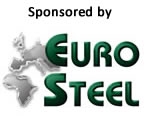 WINNER
WINNER
ND Engineering
For the Ongoing Development of RDA Technology
An industry titan, ND Engineering has been in operation since 1975. It has changed hands over the years but as of 2013 is once again 100% South african owned. Over 4 decades, it has built a reputation as a fabricator, but some of its most exciting current work comes from its collaborations with Tongaat Engineering Group (TEG) and Ionex Separations Technologies on RDA valve projects.
TEG initially developed the awardwinning RDA valve technology, working hand in hand with ND Engineering to build it. They were also selected by US based Ionex to build RDA valves for their processes, a relationship they have maintained even against considerable pressure to manufacture in China.
RDA valves offer many benefits over functionally similar systems like ISEP/ SEPTOR. For example, RDA valves don’t have flexible hoses, a part that needs regular replacement on ISEP. RDA valves are also significantly easier to maintain, since they don’t have internal mechanical gears and have easily removable piping. And unlike ISEP, RDA comes in its own modular structure, ready for field I/O connections.
RDA valves help realise practical efficiencies. Having a single moving part makes them easier to operate and gives them better on-stream availability.
Compared to ISEP/SEPTOR, an RDA valve uses far less material, making them lighter, cheaper to produce and easier to install. In operation, they use vastly less energy, less water and less process chemicals and the nature of the design means any leakage is contained and piped away. Additionally, the aesthetic appeal and low maintenance of stainless steel makes them a perfect fit for the food industry.
ND Engineering have continued to develop and build RDA valves, with each new project offering fresh opportunities to learn new things and evolve the technology. For example, new applications see the valve being deployed to work with new chemicals and in almost every case, this means selecting different grades of materials to build that RDA valve with.
Within an individual RDA valve, you might have any combination of 304L, 316L, 904L, 2205, 2507, 254SMO, carbon steel, HDPE and/or Teflon.
Development and constructability studies for the RDA valve are ongoing and ND Engineering remain committed to the project. This work has resulting in RDA valve technology entering a number of new markets. For example, RDA valves are now also used in chicory extraction, orange juice production, yellow cake uranium production and a growing list of pharmaceutical applications.
Contact : ND Engineering
Tel : 031 464 0510
Website : www.ndengineering.co.za
JOINT 1ST RUNNER UP
Efficient Engineering
For the Design and Manufacture of 3CR12 Modular Sub-Stations in a Coated HRA Finish
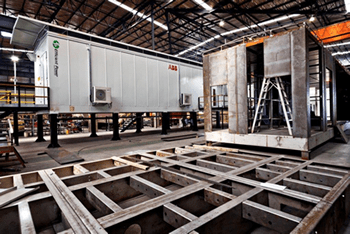
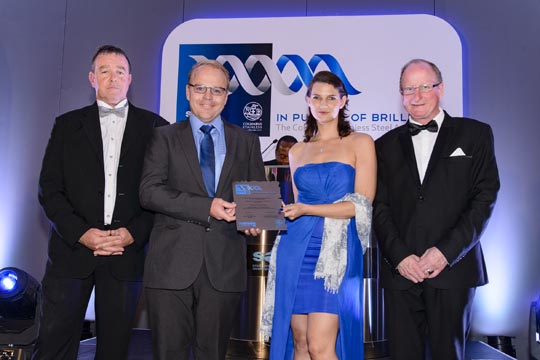
Founded in 1958, Efficient Engineering has decades of experience building large scale custom solutions for companies in a range of diverse sectors. They specialise in designing, building and deploying custom equipment to their clients’ specifications and the sectors they serve includes Mining,
Oil and Gas, Earth Moving and Materials Handling, among others.
They’re good at what they do, primarily because they approach each project in a bespoke manner - rather than supplying solutions off the shelf, they hand tailor each one to ensure its a perfect fit for their clients. One area where they have built a reputation is in the design and manufacture of customised modular substations.
Typically, substations house powerful electrical equipment. The reasons why a company might choose a modular substation is that they’re typically deployed fully equipped and unlike a traditional building, they don’t require costly groundworks. And if they’re the kind that Efficient Engineering builds, they can be whisked to another site when the job is done.
As a product, modular substations aren’t unique to Efficient Engineering, but the company has innovated a number of approaches that make their units considerably more desirable than many of their competitors. For a start, they’ve chosen to abandon the carbon steel that’s traditionally used in substation construction in favour of ferritic 3CR12 stainless steel, with a painted coating applied.
This material choice yields some significant benefits. The modular substations that Efficient Engineering build are designed from the ground up
to be fully mobile - they’re intended to be moved. But since you can’t know in advance what kind of future environments the unit will be deployed in, it needs to be able to withstand a larger array of potential corrosion than a fixed unit would. The decision to use 3CR12, then, results in a substation with increased longevity and off-site credibility.
They’ve also largely abandoned welding as a method of constructing substations, since experience has shown that these can crack over time. Instead,
they use a system of hydraulic swaged bolting, which has the knock-on advantage of having significantly lower labour costs.
Efficient’s modular substations can be up to 40 m long and 6 m wide and yet still be portable. Their hydraulic lifting system means that you don’t even need a crane to shift them. Currently, Efficient are constructing 13 of these units for mining and petrochemical companies across
Southern Africa.
Contact : Efficient Engineering
Tel : 011 928 4800
Website : www.efficient.co.za
JOINT 1ST RUNNER UP
HC Heat Exchangers
For the Design and Manufacture of Heat Exchangers for Diesel Electric
HC Heat Exchangers is the largest manufacturer of fin-coil heat exchangers in the country. They work with a range of materials and their products are used in HVAC systems, refrigeration, heat pumps and flue gas heat reclamation systems among other applications.
They were commissioned to build a full stainless steel heat exchanger for Diesel Electric. The unit is designed to provide cool, combustible gas to a generator engine where it will be used for power generation. The heat exchanger provides 800kW of cooling and dehumidification, as well as 20kW of reheating.
This unit has three subsystems.
In the pre-cooling stage hot air from elsewhere in the generator enters the unit at about 80oC. The system uses this heat to warm up a water-glycol mixture. Since it is able to utilise this ambient heat no electrical heating is required. This translates to a saving in energy consumption.
In the main cooling system the gas mixture flows over stainless steel coils and is cooled to its saturation point. This dehumidifies the gas so it can be safely provided to the generator system. For efficiency, the heat exchanger uses an array of delicate fins to increase the surface area between the cooling fluid and the gas flowing over the coils. This enables heat transfer from the gas to the coolant fluid despite the compact size of the unit.
In the re-heating system, the unit uses the heat it pulled from the pre-cooling stage to bring the gas back up to the safe operating temperature that the generator requires at entry.
All of the heat exchangers parts are manufactured from austenitic stainless steels. Both the fins and tubes used in the cooling stage are 304, with a thickness of just 0.31 mm for the fins and 0.7 mm for the tubes. The manifolds utilise SCH40 40 NB SS304 and SCH40 100 NB SS304.
The finished product is contained in a casing that supports and shelters the coils and provides mount points. This too is made of 304, at a thickness of 1.6 mm.
Contact : HC Heat Exchangers
Tel : 011 674 1237
Website : www.hcaircon.com


